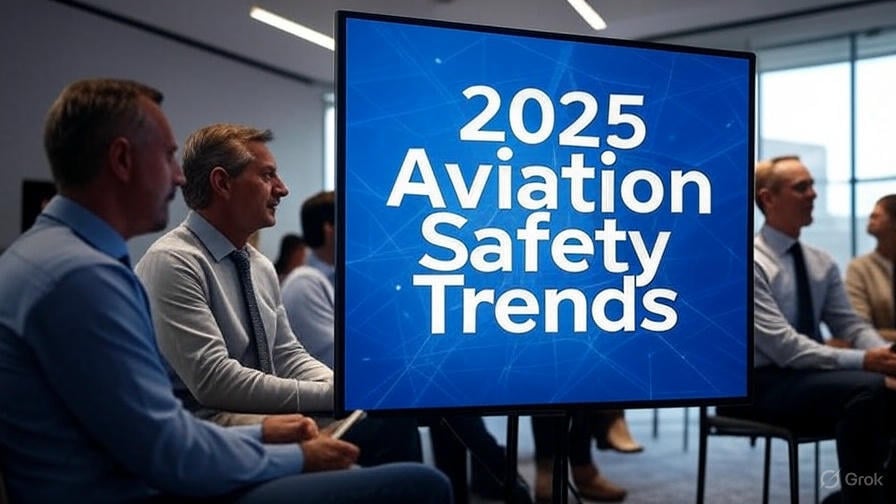2025 Aviation Safety Trends

Aviation Safety Management Systems (SMS) are at the forefront of ensuring safety in an increasingly complex industry. With regulatory changes, technological advancements, and a heightened focus on proactive risk management, aviation safety professionals must stay informed to maintain compliance, enhance safety, and optimize operations.
This comprehensive article explores the top ten SMS trends shaping aviation in 2025, offering in-depth insights, practical strategies, and actionable steps to elevate your safety programs.
1. FAA’s Expanded SMS Mandate: Navigating New Compliance Horizons
In 2024, the FAA introduced a transformative SMS rule, extending requirements to Part 135 operators (commuter and on-demand), certain Part 21 certificate holders (manufacturers), and §91.147 air tour operators. With a 36-month compliance deadline by 2027, this mandate impacts a diverse range of organizations, from small charter services to large-scale air tour providers. The rule emphasizes proactive hazard identification, risk assessment, and safety performance monitoring to prevent incidents.
Key Takeaway: Begin preparing now by conducting a thorough gap analysis to identify compliance shortfalls. Develop scalable SMS frameworks tailored to your organization’s size and complexity. Tools like SMS Pro can automate documentation and streamline processes. Engage stakeholders, including pilots, maintenance crews, and management, to ensure buy-in and foster a unified approach to meeting the 2027 deadline.
2. ICAO Annex 19: Driving Global SMS Standardization
The International Civil Aviation Organization’s (ICAO) Annex 19 provides a global blueprint for SMS, mandating its adoption across airlines, airports, maintenance organizations, and manufacturers. This harmonization ensures consistent safety practices worldwide, focusing on structured hazard reporting, risk mitigation, and performance-based oversight. As international operations grow, compliance with Annex 19 is non-negotiable for cross-border interoperability.
Key Takeaway: Align your SMS with ICAO’s four pillars: safety policy, risk management, safety assurance, and safety promotion. Leverage ICAO’s Safety Management Manual (Doc 9859) and regional resources from bodies like EASA or IATA. Implement standardized data collection protocols and conduct regular audits to ensure your SMS meets global benchmarks, enhancing credibility with regulators and partners.
3. Fatigue Risk Management Systems (FRMS): Tackling Fatigue Head-On
Fatigue is a leading contributor to aviation incidents, particularly for flight crews on irregular or long-haul schedules. Fatigue Risk Management Systems (FRMS), integrated into SMS, use biomathematical models like SAFTE-FAST to predict fatigue based on sleep patterns, circadian rhythms, and work schedules. These systems are critical for ICAO-aligned operations and are gaining traction as a cornerstone of crew safety.
Key Takeaway: Implement an FRMS by adopting tools like SAFTE-FAST to optimize crew scheduling and minimize fatigue risks. Train safety teams to recognize fatigue indicators, such as reduced alertness or decision-making errors. Integrate FRMS data into your SMS Pro portal for real-time monitoring, and collaborate with crew members to develop fatigue-reporting protocols that encourage transparency without fear of reprisal.
4. Digital SMS Tools: Revolutionizing Safety Data Management
Digital platforms like SMS Pro, SafetyCulture, Coruson, and Q-Pulse are transforming aviation SMS by automating hazard reporting, tracking safety performance indicators (SPIs), and enabling real-time data analysis. These tools are particularly valuable for small operators in remote regions, where manual processes are resource-intensive. Cloud-based solutions offer scalability, mobile access, data protection, and seamless integration with existing systems.
Key Takeaway: Invest in a digital SMS platform that aligns with your operational needs, prioritizing user-friendliness and customization. Ensure the tool supports mobile reporting to empower frontline employees, such as ground staff and pilots, to log hazards instantly. Regularly update dashboards to visualize SPIs and share insights with leadership to drive data-informed decisions.
5. Building a Proactive Safety Culture: The Heart of SMS
A robust safety culture is the foundation of an effective SMS. Overcoming complacency, encouraging non-punitive reporting, and fostering leadership commitment are essential to creating an environment where safety is a shared priority. A strong safety culture not only reduces incidents but also enhances employee morale and operational efficiency.
Key Takeaway: Conduct annual safety culture surveys to gauge employee perceptions and identify areas for improvement. Provide training on non-punitive reporting and human factors, emphasizing the value of every report. Engage leadership to model safety-first behaviors, and implement recognition programs to celebrate employees who proactively identify and address hazards.
6. Human Factors: Mitigating Complacency and Cognitive Risks
Human factors, including complacency, distraction, and poor decision-making, contribute to over 70% of aviation incidents. Integrating human factors analysis into SMS helps safety professionals identify behavioral risks and implement targeted interventions. This focus is critical for high-risk roles like pilots, air traffic controllers, and maintenance technicians.
Key Takeaway: Incorporate human factors training into your SMS, using real-world case studies to highlight the dangers of complacency. Conduct root cause analyses for incidents to uncover behavioral triggers, and use simulations to reinforce situational awareness. Regularly update training programs to address emerging human factors challenges, such as automation over-reliance.
7. SMS Data Protection: Striking the Right Balance
Determining what SMS data employees should access is a growing concern as organizations balance transparency with security. While open reporting drives safety improvements, protecting sensitive data—such as incident details or proprietary metrics—is critical to comply with data privacy regulations and prevent misuse.
Key Takeaway: Develop clear data access policies within your SMS, specifying which data categories (e.g., hazard reports, audit findings) are accessible to different roles. Implement role-based permissions in digital SMS tools to restrict sensitive information while maintaining open channels for reporting. Regularly audit data access logs to ensure compliance with regulations like GDPR or CCPA.
8. Scalable SMS for Small Operators: Safety Without Complexity
Small operators, including single-pilot operations and those in remote regions, face unique challenges in implementing SMS due to limited resources and personnel. Frameworks like the International Standard for Business Aircraft Operations (IS-BAO) and guidance from Civil Aviation Authorities (CAAs) offer tailored solutions to make SMS accessible and effective for non-complex organizations.
Key Takeaway: Adopt a phased SMS implementation approach, starting with core components like hazard reporting and risk assessment. Use cost-effective tools like SMS Pro or free templates from the FAA’s SMS Voluntary Program. Train a small team to champion SMS adoption, and leverage peer networks, such as NBAA or EASA forums, to share best practices and overcome resource constraints.
9. Demonstrating SMS ROI: Making the Business Case
SMS adoption delivers measurable financial benefits, including reduced insurance premiums, lower incident-related costs, and improved operational efficiency. For safety professionals, quantifying return on investment (ROI) is essential to secure leadership support and justify resource allocation, particularly in cost-sensitive organizations.
Key Takeaway: Track SMS-related metrics, such as incident reduction rates, maintenance cost savings, and employee reporting trends, to build a compelling ROI case. Use industry benchmarks, like IATA’s SMS cost-benefit studies, to contextualize savings. Present findings to leadership through concise reports, highlighting how SMS enhances both safety and the bottom line.
10. Safety Performance Indicators (SPIs): Measuring What Matters
Safety Performance Indicators (SPIs) are the backbone of SMS effectiveness, providing data-driven insights into risk trends and mitigation success. Tailored SPIs—such as incident rates, reporting frequency, or training completion rates—enable organizations to monitor safety performance and proactively address emerging hazards.
Key Takeaway: Develop SPIs that reflect your organization’s unique risk profile, such as runway incursions for airports or maintenance errors for MROs. Use digital dashboards to track SPIs in real time, and conduct quarterly reviews to adjust safety strategies. Share SPI results with employees to foster transparency and reinforce the impact of their contributions.
Conclusion: Leading the Way in Aviation SMS Excellence
The aviation SMS landscape in 2025 is dynamic and multifaceted, driven by regulatory mandates, technological innovations, and a cultural shift toward proactive safety management. By embracing these ten trends—FAA compliance, ICAO alignment, FRMS, digital tools, safety culture, human factors, data protection, scalability, ROI, and SPIs—safety professionals can build resilient, future-ready SMS programs. The key is to stay proactive, leverage cutting-edge resources, and foster collaboration across all levels of the organization.
Call to Action: Ready to take your SMS to the next level? Explore platforms like SMS Pro, dive into FAA and ICAO resources, and connect with industry peers through forums like NBAA, IATA, or EASA conferences. Share your experiences, challenges, and successes in the comments below to inspire the aviation safety community!







